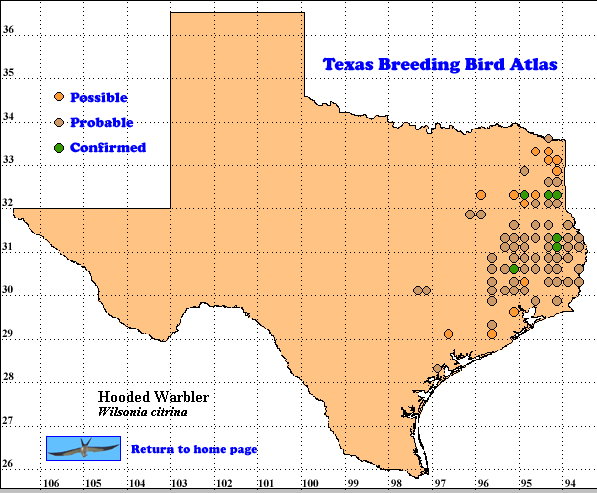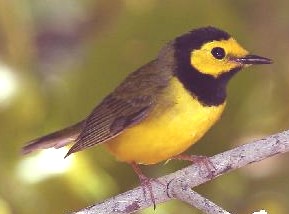The Hooded Warbler is a neotropical migrant that summers in the eastern U.S. to southern Ontario, Canada (Bent 1953). The most southwestern portion of its breeding range lies in the bottomlands of east Texas. Heard much more often than seen, a male announces his presence in the undergrowth with a rapid, sweet whistle sometimes described as ta-wee ta-wee ta-wee wit weer. Some males sing a variation of that, perhaps described as ta-wee ta-wee ta-wee weechy weechy. Regardless of the song type, the notes are sweet, maybe flirtatious, with the final wit weer of the most common song sounding much like a human’s “wolf call”. Despite the numerous syllables in the song, it is delivered quickly, in usually under two seconds.
The Hooded typically feeds in the understory, where it gleans insects from branches and leaves, also descending to the ground after prey. While foraging, it flits about actively, occasionally catching insects on the wing in flycatcher fashion. It has a peculiar habit of frequently spreading its tail to reveal distinctive white tail spots. On average, the male feeds higher in the vegetation than the female, often several feet from the ground. The female usually feeds on or very near the ground (Morse 1989).
The male is a striking 12.7-15.3 cm (5-6 in.) bird, with a bright yellow forehead and face surrounded by a black hood. Upperparts are olive without wingbars, and underparts are bright yellow. The female and immature are similar to the male, but duller and usually with only a hint of the black hood (Evans et al. 1994).
DISTRIBUTION: Breeding season records of Hooded Warbler in Texas generally range from the northeast corner of the state in Bowie County (latilong 33094, quads B2, C3, C6, and E4), roughly southwestward through Smith, Anderson, and Freestone counties to Bastrop County (latilong 30097, quads A2 and B4). Then southward to the middle Texas coast in Aransas County (latilong 28096, quad C7). Its distribution in east Texas is nearly identical to that of the Swainson’s Warbler; (Limnothlypis swainsonii) indeed, the two species often occur together in moist creek and river bottoms. Confirmed breeding during the years of the TBBA (1987-1992) occurred in only six instances, due mainly to the species’ preference for thick undergrowth where few humans care to tread.
SEASONAL OCCURRENCE: Hooded Warblers usually begin arriving in Texas from their wintering grounds in late March and early April (Oberholser 1974). Their winters are spent in the humid lowlands from Mexico to Panama (Morse 1989). Males are normally singing on territory in east Texas by early to mid-April (pers. obs.). They sing often while foraging low in the undergrowth, but will also occasionally sing from perches quite high in a mature tree while establishing and maintaining their territories. Breeding dates range from about mid-April until at least mid-July in Texas. The six confirmations during the years of the TBBA ranged from April to July. A female was on nest in April 1990 (no date specified), two separate pairs were feeding young on 14 July 1991, and a nest with eggs was found in July 1992 (no date specified). Fall migration may begin as early as August, and most birds are gone from Texas by mid-October (Oberholser 1974).
BREEDING HABITAT. The Hooded Warbler is a denizen of thick, shaded, leafy undergrowth in creek and river bottoms in east Texas. It occurs both in the luxuriant understory present in some mature deciduous or mixed woodlands, and in moist second growth forests that were cut over four to five or more years earlier (pers. obs.).
The nest is usually placed 0.3-2 m (1-6 ft) above the ground, rarely to 6 m (20 ft), inconspicuously in a thicket or tangle (Ehrlich 1988). It is a small, well-made nest, tightly woven with dead leaves, plant fibers, and weeds, and is bound with spider silk. It is lined with finer materials, such as grass or mammal hair. The female lays three or four eggs, rarely five. The creamy white, slightly glossy eggs are spotted with brown. Incubation normally lasts about 12 days, and fledging occurs in merely another 8-9 days. This rapid “turnaround” time allows the species to produce two clutches in a season, particularly in the southern U.S. (Harrison 1975).
A nest containing four eggs was found in May 1992 in the Bacon Creek bottom about 16 km (10 mi) south of Longview in northern Rusk County. Nestled against the side of a cane stalk, it was perched on a spindly protrusion from the stalk about 1.5 m (5 ft) above the ground in a very thick, dark portion of the cane thicket. The tightly but neatly woven mass consisted primarily of cane leaves. The female was an extremely close sitter that would flush only on a human’s approach of closer than 1.5 m (5 ft). Once flushed, she would flutter to the ground and attempt to draw the intruder away from the nest with a broken wing distraction display (pers. obs.).
STATUS: In general, the Hooded Warbler is an uncommon breeding bird in east Texas. In extensive areas of its preferred bottomland habitat, however, it is reasonably easy to find. The species is probably most common in Texas very close to the Louisiana state line (pers. obs.). In northern Rusk County in the summers of 1992-1994, three singing males have been heard consistently at one time with the observer at a fixed location. This suggests that pairs may be spaced perhaps only 50-100 m (55-110 yd) apart in good habitat.
TBBA data indicate the breeding range in Texas has remained essentially the same through the latter half of the 20th century (Oberholser 1974). It is difficult to determine whether its abundance in east Texas has changed over time, however, because of its relative scarcity and affinity for thick growth in bottomlands (see also White 2001). Text by Guy G. Luneau (Posted 2007)
 Literature cited:
Literature cited:
Bent, A. C. 1953. Life histories of North American wood warblers. U. S. Nat. Mus. Bull. no. 203.
Ehrlich, P. R, D. S. Dobkin, and D. Wheye. 1988. The Birder’s Handbook. Simon and Schuster, New York.
Evans Ogden, L. J. and B. J. Stutchbury. 1994. Hooded Warbler (Wilsonia citrina). In The birds of North America, No. 110 (A. Poole and F. Gill, eds.). The Birds of North America, Inc., Philadelphia, PA.
Harrison, H. H. 1975. A field guide to birds’ nests. Houghton Mifflin, Boston, MA.
Morse, D. H. 1989. American Warblers. Harvard University Press, Cambridge, MA and London.
Oberholser, H. C., and E. B. Kincaid. 1974. The Bird Life of Texas. University of Texas Press, Austin, TX.
White, M. 2001. Birds of northeast Texas. Texas A&M University Press, College Station.
